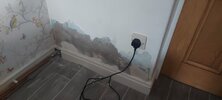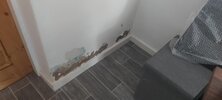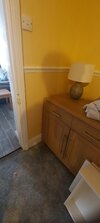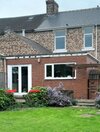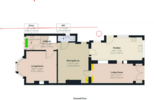Hi,
We have just moved into a Victorian semi-detached house, and all is good, but there is an area of 'rising damp' which was picked up on our survey but now I am able to have a better look at.
please see attached pics. The wall with the plug socket is the old kitchen, and the wall at 90 degree to the left is the party wall between properties. The floor in this room is concrete.
The other pic of the yellow wall covering, is the room adjacent and from the door frame to the corner the wallpaper alternates between dry and wet depending on the weather. When we moved in, the weather was torrential rain and the wallpaper was very wet. The party wall to the chimney breast is not wet (or at least not to touch) and looks fine. The floor in this room is timber.
There are central heating pipe running through this wall, but we have not seen any loss of pressure at the boiler so I assume they are not leaking.
I assume there is no DPC between the two rooms. The other pic shows a similar area on the other side of the door, and yet the wallpaper on the other side is bone dry?!?
What would be the cause and remedy of this situation? We will get pro's in to do the work, but I don't want to be fleeced with a 'temp fix'
Both flooring surfaces under the carpet / lino are dry.
I appreciate any advice.
Thanks
We have just moved into a Victorian semi-detached house, and all is good, but there is an area of 'rising damp' which was picked up on our survey but now I am able to have a better look at.
please see attached pics. The wall with the plug socket is the old kitchen, and the wall at 90 degree to the left is the party wall between properties. The floor in this room is concrete.
The other pic of the yellow wall covering, is the room adjacent and from the door frame to the corner the wallpaper alternates between dry and wet depending on the weather. When we moved in, the weather was torrential rain and the wallpaper was very wet. The party wall to the chimney breast is not wet (or at least not to touch) and looks fine. The floor in this room is timber.
There are central heating pipe running through this wall, but we have not seen any loss of pressure at the boiler so I assume they are not leaking.
I assume there is no DPC between the two rooms. The other pic shows a similar area on the other side of the door, and yet the wallpaper on the other side is bone dry?!?
What would be the cause and remedy of this situation? We will get pro's in to do the work, but I don't want to be fleeced with a 'temp fix'
Both flooring surfaces under the carpet / lino are dry.
I appreciate any advice.
Thanks


